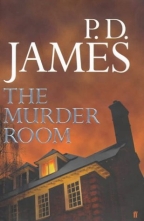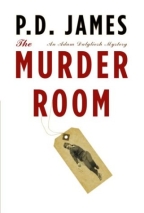The Murder Room
Faber and Faber Limited
UK Hardcover First
ISBN: 0-571-21821-0
Publication Date: September, 2003
371 Pages; £17.99
Date Reviewed: September 15, 2003
Reviewed by: Terry D'Auray © 2003
|

|
The Murder Room
Random House/Alfred A. Knopf
US Hardcover First
ISBN:1-400-04141-4
Publication Date: November 18, 2003
432 Pages; $25.95
Date Reviewed: September 15, 2003
Reviewed by: Terry D'Auray © 2003
|

|
|
REFERENCES
|
COLUMNS
|
|
Mystery,
General
Fiction
|
|
Writing for over 40 years, with sixteen novels in total, two
featuring young female detective Cordelia Gray and fourteen with
perpetually middle-aged Adam Dalgliesh, P.D. James has become a force
majeur in detective fiction. Rooted in the tradition of classic
British female mystery writers like Sayers, Marsh and Tey, she has
edged the boundaries of that genre ever wider. Criminal detection and
investigations of death provide but a latticework through which James
weaves her emblematic elements of character, setting and theme.
"The Murder Room" takes place in Dupayne, a small, private museum
devoted to the history of 1920s and 1930s now owned by three
siblings. The Murder Room itself features exhibits and instruments
from the most famous crimes of that period. Dupayne Museum will close
unless the three trustees can agree on a new lease as mandated by
their father's will. Marcus, the oldest brother, a newly retired
public servant and his sister Caroline, headmistress of a nearby
upper crust girl's school, favor maintaining the museum for reasons
both philanthropic and personal. The middle brother, Neville, a
psychiatrist, does not. Shortly after an acrimonious board meeting,
one of the siblings is murdered, the murder methodology exactly
echoing one of the infamous crimes displayed in the museum's Murder
Room. Adam Dalgliesh and his team of investigators from CID are
summoned to unravel the crime quickly and quietly. But of course, it
is not to be that simple, as they discover a tangle of personal
relationships and a mountain of possible criminal motivations.
'The Murder Room' is a classic James novel displaying many of her
trademark narrative components. It is set, as are most of her novels,
in a self-contained community slightly outside the mainstream of
contemporary life. Dupayne Museum is reminiscent of the Anglican
theological college of 'Death in Holy Orders', the Paddington Church,
St Matthews, in 'A Taste for Death', the Peverell Press Publishing
House in 'Original Sin'. It features as primary characters siblings
whose histories are layered and complicated, and highlights the
class-distinctions between the educated upper crust and the
common-sense working class that only Adam Dalgliesh transitions with
ease. The narrative revolves about a theme - here, murder in a
socio-historical context or how murders and their outcomes reflect
the times in which they are committed. The story is rooted in strong
passion, which in this as in all James' novels, is perilous.
'The Murder Room' is above all, a novel of characterization and
detail. James creates her characters with exquisite care, describing
their facial features, their bone structure, their height, and their
dress. Everyone is brought to life physically, psychologically, and
emotionally. Imperious Caroline, hard-working Tally, efficient and
controlling Muriel Godby. James exposes each - their passions, their
disappointments, their prejudices and their pleasures and, through
such extensive definition, they become familiar and involving. All
the while we know, of course, that one of them has committed
murder.
Attention to detail extends to the settings as well as the
characters. Streets, houses and interiors are described with
precision in lush prose. Architecture, art, history, books, flowers,
soil, sun - all are noted, and all help embroider the spell. James'
detailed descriptions are enveloping, dense, rich and absorbing. The
pacing is languid as James sets her stage. 'The Murder Room' is fully
a third complete before a crime occurs.
Adam Dalgliesh in 'The Murder Room' remains the masterfully
created character who has anchored fourteen previous novels. He's a
skilled detective and a published poet, a tall, dark, handsome loner,
scarred by the loss of his wife and son in childbirth. Erudite and
well educated, he's also humble and human. And in 'The Murder Room',
he is a bit distracted by the love of Emma Lavenham, the beautiful
scholar introduced in 'Death in Holy Orders'. If I have a quibble
with this book, and it's a mere quibble, it's that James introduces
Dalgliesh's personal emotional turmoil at the outset, revisits it
midway through the narrative only once and only briefly, and revives
it at the very end, in a style reminiscent of a schmaltzy Hollywood
movie. Quite overly theatrical for James, I think.
The plotting in 'The Murder Room' is adequate, well thought out
and well developed, but I never read James for plot. I'm impatient
with plots that turn on acutely observed minutia - the position of a
light switch, or misplaced keys or unaccounted minutes. It simply
doesn't matter to me who did it and I take no satisfaction in trying
to figure it out beforehand. I suspect I'm in the minority here, and
that most readers revel in doing exactly that. For them, James plays
fairly, providing clues and twists and a credible denouement.
While not an author I would elect to read on a daily basis, James
paces her releases to suit me perfectly and I look forward to each
new one. She's grandly old-fashioned (despite the cell phones and
traffic jams) and her themes are timeless. I read James for her
linguistic artistry, solely to be enveloped by her prose. She's a
choreographer of words, writing an exquisite ballet danced by an
elegantly costumed corps, to a full orchestra. She's an entrancing
writer and 'The Murder Room' ranks as one of her best.

